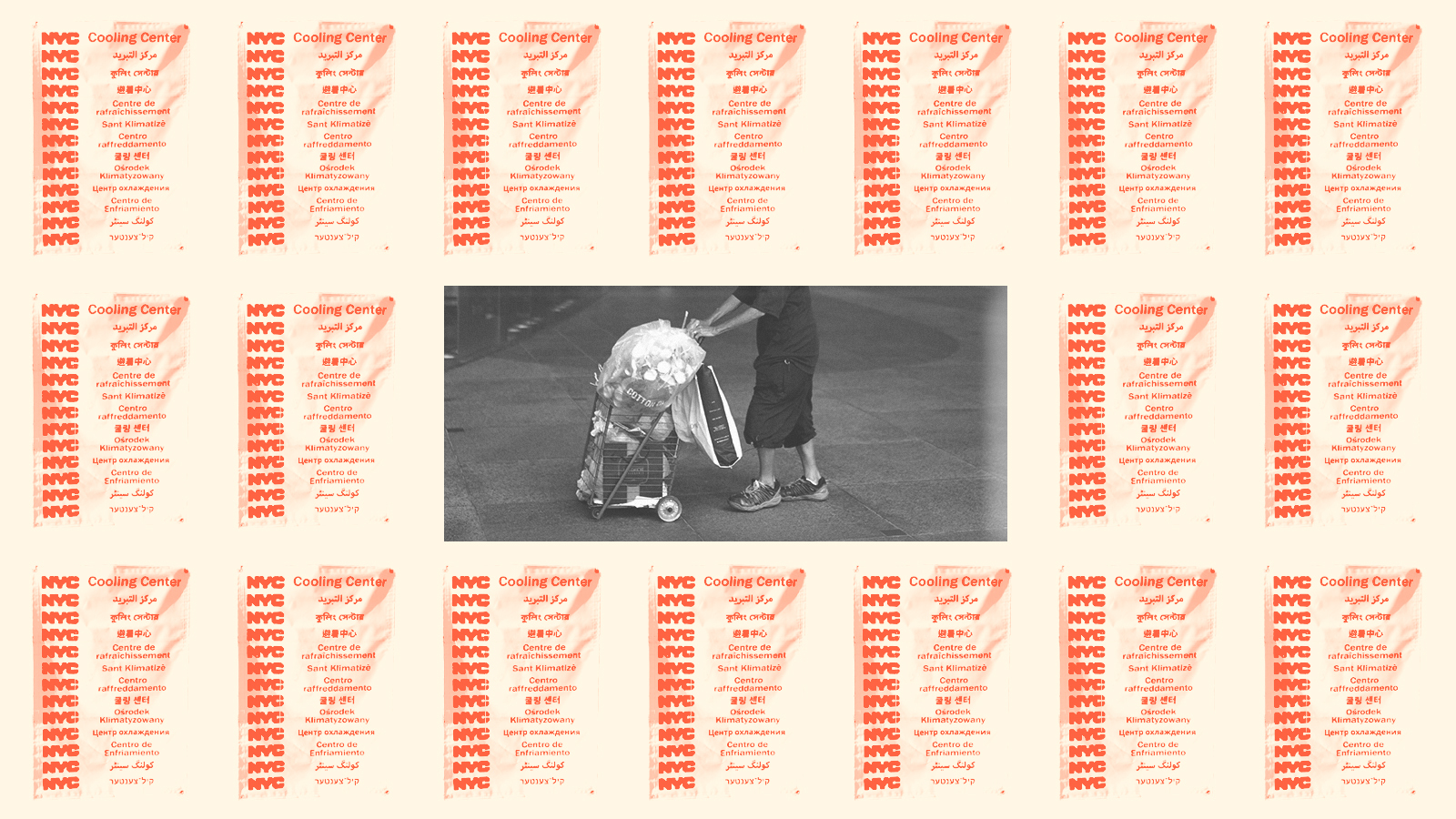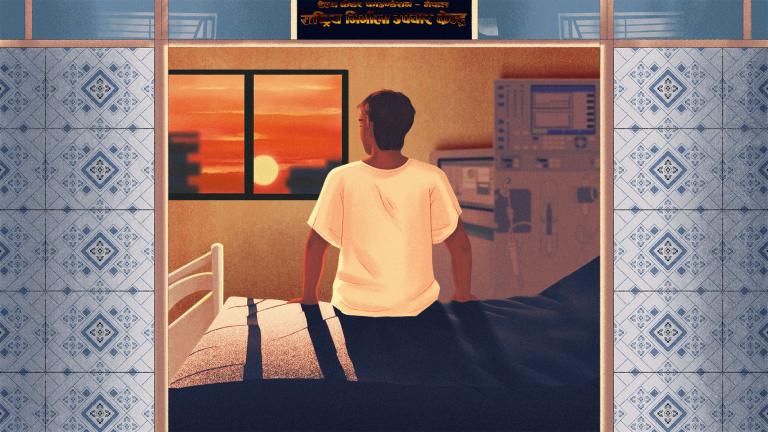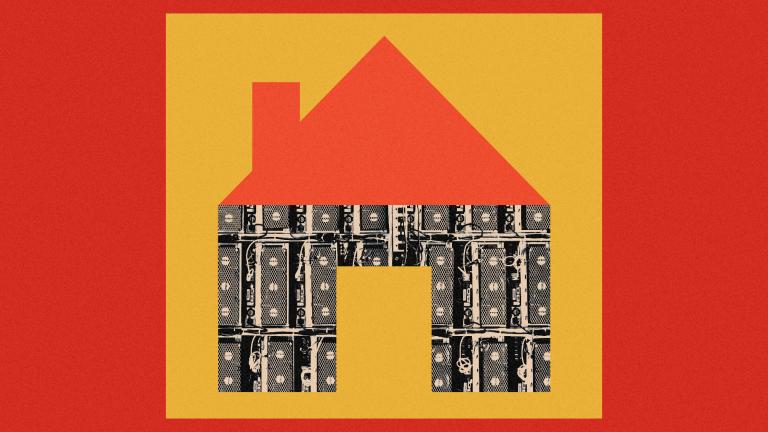Mone Choy is 68 and lives in the New York City neighborhood of Inwood, at the northern tip of Manhattan, on a fixed disability income of $1,901 per month. Her rent is frozen at $1,928. She lives with chronic health issues that render her unable to work. In addition to a few other intermittent gigs, Choy covers the rest of her expenses by collecting bottles from her building’s recycling and taking them to a nearby redemption center.
One luxury her budget doesn’t leave room for, even during a heat wave like the one that scorched the city last week — and remains ongoing around the world — is air conditioning. She has several AC units in her apartment (gifts from friends concerned about Choy’s health) but because she can’t afford to turn them on, they sit uninstalled.
“When I experience heat, my blood pressure shoots up and I get dizzy,” Choy said. To keep cool on hot days, Choy has to find air-conditioned spaces elsewhere in the city. To do so, she relies on a resource that the city government has touted as central to its response to extreme heat: the several hundred “cooling centers” that open across the city when a heat advisory is issued. These are listed on a city website, with a map of accessible sites. Almost all of the cooling centers are in libraries and senior and community centers. The list also includes museums, Salvation Army locations, and Petco stores.
Last Friday, Choy woke up at 4:30 a.m., three hours before the heat would make her apartment unbearable, to pack everything she would need for her day’s journey into a shopping cart. She assembled her lunch, snacks, incontinence supplies, and an extra change of clothes in case of an unexpected lack of bathroom access. “I don’t have extra money to … buy something I forgot,” she said.
Next, she checked the weather report and transit system service alerts, and planned her route. “I take the cooling center information and put that together with my own personal knowledge of senior centers and the ones I think are better funded and less liable to have broken toilets — that happens because a lot of senior centers are located in NYCHA [public housing] buildings.”
She makes her choice of senior center based on its proximity to one of the city’s publicly listed Privately Owned Public Spaces, or POPS. These are spaces inside private buildings like corporate offices, and they are usually made accessible to the public by the site’s developer as part of a deal with the city, in exchange for zoning concessions. Choy says the cooling centers located at senior centers tend to close early for cleaning — “you’re pushed out by 4:00, 4:30 — 5:00 if you’re lucky, the hottest part of the day.” The privately owned centers generally stay open until 9:00 or 10:00. After she’d packed her bags on Friday, Choy left home at 6:00 to catch the bus to St. Peter’s Church in Midtown, where she planned to stay until it closed.
There were about five other people using the senior center as a respite from the heat, but more seniors came in at lunchtime for the free meal it offered. Normally, Choy is a very sociable person and likes to chat with the other visitors, but on Friday she didn’t feel up to conversation. She said she was “fatigued and resentful and just in a place of general low grade dread. I’m going, ‘It shouldn’t be like this in June, so I’m dreading what July and August will be like.’” At the cooling center, she passed her time reading the news on her phone and feeling increasingly dispirited.
One place she’d love to be on a hot day is a library — she loves to read, and it’s an environment where “you don’t have to put up with people giving off crazy energy you don’t wanna be around.” But in her neighborhood, Choy said, the library was closed to make way for a new apartment building. It’s been replaced with a temporary library that lacks a public bathroom.
Heat waves have put a spotlight on the waning fortunes of New York City libraries, which have become a cultural battlefront in municipal politics under the administration of the city’s mayor, Eric Adams. In November, Adams announced budget cuts to the library system that ended Sunday services at libraries citywide. During the negotiations for next year’s budget — for which the deadline is this Sunday — he proposed further cuts to the library system that would have had the likely effect of closing most libraries’ doors on Saturdays as well as an additional $125 million from the libraries’ capital budget, which is the source of funding for repairs to library HVAC systems.
The library cuts have been the source of protests and opposition from the City Council — and yesterday, the intense backlash appeared to bear fruit. In a dramatic eleventh-hour reversal, the mayor agreed to reverse last year’s library budget cuts, restoring funding that would likely allow Sunday service to resume at libraries citywide. It is not yet clear whether the new budget will include the $125 million in capital budget cuts from libraries.*
In a press conference before the heat wave, Adams said, “Global warming is real and we want to make sure that climate change and the heat that it brings with intensity, that people are aware of how to deal with it during a heat wave.” He touted the online map of cooling centers and mentioned that the sites included “many of our public libraries.”
In a landmark 2002 book, “Heat Wave: A Social Autopsy of Disaster in Chicago,” about the 1995 heat wave that killed more than 700 people and prompted the formation of New York’s cooling centers, the sociologist Eric Klinenberg established that access to social infrastructure and public space helped determine which neighborhoods had the most deaths. He later served on a New York City climate planning commission called PlanYC, where, he told Grist, he “advocated for the city to supercharge its branch libraries … so that they could be updated with heat and air conditioning systems that worked reliably and converted into emergency relief centers during extreme weather.”
In his view, the city’s current approach is a far cry from that vision. “Mayor Adams has consistently shown that the library is not a priority when it comes to city services. And so as I see it, it’s hypocritical for his administration to tell New Yorkers they can rely on the library during a dangerous heat wave, when they’ve essentially made it impossible for New Yorkers to rely on the library in their daily lives,” Klinenberg said.
But the Adams administration has reacted touchily to criticisms that it’s undermining its own heat relief efforts with the library budget cuts. Last week, Brad Lander, the city’s comptroller, noted that, on the first day of the heat wave last week, all the city’s libraries — 41 percent of the cooling centers — were closed because Juneteenth was a federal holiday. Zachary Iscol, the commissioner of emergency management, who oversees the cooling centers, took to social media to call the comptroller’s comments “a pretty significant misrepresentation.”
Lander told Grist the figure came directly from the city’s data on its cooling centers, which his office analyzed in a 2022 report. That report also found that fully half of the cooling centers were listed as closed on Saturdays, and 83 percent were closed on Sundays.
“We are not currently investing in the civic infrastructure that we need to keep people safe in the climate crisis anywhere near as much as we know we need to. The libraries are the biggest example of that,” Lander said.
Last Friday afternoon, Choy decided to leave the senior center to buy a bag of ice. As soon as she stepped outdoors, she said, “I just remember getting instantly sweaty. It was hard to breathe and I was so grateful that the little drugstore was right across the corner and I didnt have far to walk. I stayed in the store for 15 minutes before I made my purchase. I felt my heart starting to beat really fast; I didn’t want that to move into a lightheaded situation.”
She went back to the senior center and stayed there until 3:30, when the cleaning staff began spraying down the tables and she felt unwelcome. It was 94 degrees out, but because she had already bought the bag of ice to cool her down for the trip back to Inwood, Choy decided to ride the bus back uptown instead of walking to the nearby POPS. When she got there, she sat in the air-conditioned Manhattan Mini Storage locker she rents for around a dollar a day and stocks with books and bottled water.
Some 350 people die annually of heat-related causes in New York City. Only a handful of these cases are heat-stress deaths, or those directly caused by heat. In most cases, the heat exacerbates people’s existing illnesses and comorbidities. Among the most important risk factors, according to city data, is access to home air conditioning — and the funds to turn it on.
“Given that extreme heat is by far the deadliest impact of climate change already — and, sadly, very likely to be much more so in the years to come — we are nowhere near where we need to be in getting ready for it,” said Lander.
In what should ostensibly be a straightforward policy solution, the state offers low-income residents help with heating and cooling their homes through its Home Energy Assistance Program — but the assistance offered through this program heavily skews toward heating. The limited funds available for cooling assistance can only be used to buy an air conditioner, not to pay for running it — and what’s more, these funds tend to run out early every summer. Choy carefully monitors her power usage to ensure she doesn’t spend more than the low-income subsidy she receives from her power company, Con Edison. “If I go over, then I have to carry a balance, and then now you have to deal with the rules of ConEd. Do they want to do a payment arrangement? How long do they let you go with arrears,” she said.
Choy’s apartment takes a while to cool down, even after temperatures outside have subsided. So at around 8:30, once it had cooled down enough for Choy to feel comfortable outdoors, she left the storage center and sat on a bench in her neighborhood. At 11:30, she headed home and went to sleep, prepared to repeat the day’s journey in the morning.
New York City is only at the beginning of what is expected to be an unusually hot summer. Temperatures usually climb in July and August, and could also be increased by a La Niña weather cycle. For Choy, this means more trekking between cooling centers, and in her experience, she sees a signal of what’s in store for many more people — particularly the indigent, elderly, and disabled — as global temperatures rise.
“I don’t think a lot of people make this connection, but I’m purposefully claiming myself to be a climate refugee,” Choy said. “I feel like I’m a canary in the mine. The way I live every summer, it’s how a lot of people are going to have to live.”
*Update, June 28, 11:35 am: This article has been updated to reflect the latest developments in New York City’s 2025 budget negotiations.




